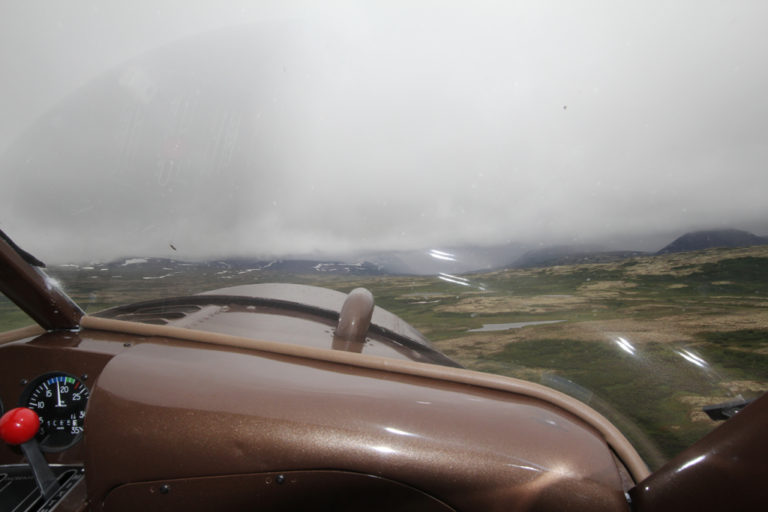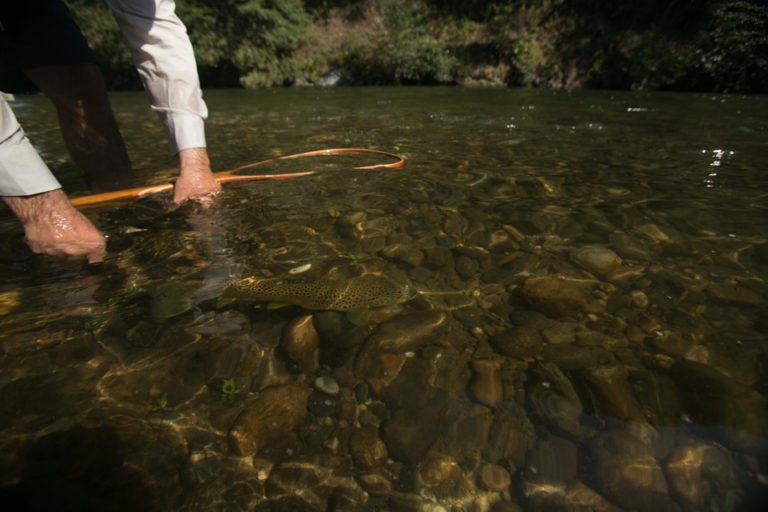From Sacramento to put-in required five flights over a two day period. On the second to last leg of the flight, we stopped at Rainbow River Lodge to load the plane for the final push to put-in.

After waiting for the cloud ceiling to lift, we were on our way and set to arrive mid day.

The pontoons of the small plane settled on the water without even a bump, and we motored toward the beach.

In a few minutes we are off-loading all of the gear that will support us for a 6 day float down American Creek – which is actually a river with a flow of about 1200 cfs. Our put in is Hammersley Lake, about 60 miles south of the southern shore of Lake Illiawma.

Our guide , Jon Streeter quickly inflates the 14 foot raft, attaches the oar frame, and begin loading the gear –tents, stove, chairs, cots, spare oar, water filter system, bear box with all of our food….. our gear goes on as well, fly rods, and equipment, clothing for all types of weather, toilet kit, cameras, and a couple of books – everything in waterproof bags.

For the next 6 days, we will live in our boots and waders, and layered clothing that ranges from only a T-shirt on a day when the temperature exceeds 80 degrees, to seven layers of clothes – (everything I had), when we encounter cold rain, heavy winds, and temps in the low 40’s.
Now loaded with our gear, plus three guys, Jon, my son Robby, and myself we slowly enter the creek. Over the next six days we will cover about 45 miles to reach our take out at Lake Colvill.

The first fish belongs to Robby, a 22 inch rainbow that falls for a size 14 Adams. The weather is drizzly and very wet, there is no wind; this section of the river is very wide, wadeable all the way across, with lots of small riffles and long glassy runs. We are using 0X tippet – they are not leader shy.

The afternoon passes quickly – we land numerous rainbows up to 23 inches. But now we have to get down the river a couple of miles and set up camp. A small damp, gravel bar will be our home for the night. It looks singularly uninviting until our cook tent goes up, some chairs get set up, and we start snacking on some cheese, salami, and crackers. At 11 o’clock in the evening, the sun still has not set, we go to bed with our hats shading the still bright light.

On our second day we remain in tundra terrain, and camp about 100 yards from a long deep run, with a large back eddy on the far side. Nymphing the run immediately produces a nice char, and then another and another, and another. Robby and Jon wade across and search for an angle to present a dry fly in the eddy, and ‘boom!’, its fish on with a big rainbow.

The char hug the bottom and only seldom will jump after being hooked, but the quantity of them in this run is astounding.

Now we are moving down into heavily forested terrain. We see our first grizzly with two cubs about a mile away. She is maneuvering down a steep slide area several hundred feet above the river when she loses her footing and rolls head over heels for 100 feet or so.

Well, it just shows that its not just humans that take risks in the heights, and it turns out she appears to be uninjured. At camp that night we are introduced to Alaska’s national bird, the mosquito.

I have a spray bottle of 100% Deet and it is my constant companion for the next few days. Our guide Jon who is exposed for the entire season is reluctant to use Deet on a daily basis, so he wears a head net.

As we lose altitude, more grizzlies appear like ghosts moving in and out of the dense brush. They want nothing to do with us. In fact when they are close they refuse to make eye contact.

They just turn and leave, or keep moving on. It is clear that neither party wants anything to do with the other.

The gradient of the river is steeper now, about 450 feet per mile. Lots of pocket water; the river braids into multiple small channels. Several times we are forced to exit the raft and clear away logs and brush to keep moving. At one point the river comes together and there is a huge rapid – class 4, which Jon expertly negotiates.

On our 4th day we have dropped over 1000 feet in elevation and we start to see a few fleeting red forms in the water – sockeyes! This is what is drawing the bears, but as yet, the sockeye are still too few in number and too fresh and fast for the bears to catch them.

The weather changes to unbelievably hot 85 degrees or so. Moose flies, which are gigantic versions of horse flies buzz around us constantly. The fish shut down – we don’t get a hit for hours-, so we entertain ourselves killing moose flies with our hat brims.

Jon offers us his own mouse pattern – made something like a gurgler with gray foam and of-course legs and a tail. This pattern, and some big stimulators produce well.

It is hard work, we have to wade down the middle of the river and work the banks and pocket water… but in my view, there is nothing more satisfying in fly fishing that drawing strike with such a presentation.

In one small run I hook a sockeye. It is nine pounds of saltwater muscle. In a few seconds all my line and most of my backing is off the reel. The fish is 150 yards down the river. John Streeter is trying to get a hold of my fly line (before I lose the whole thing), and the fish is now thrashing just a few feet from Robby, who now tails it.

The fish turns out to be dinner – salmon fritters – just a couple of hours later.

The river opens up as it approaches the lake; the terrain is marshy, the river now 200 feet wide with a surface like glass. Robby dabbles again with a parachute Adams, and lands the biggest rainbow of the trip, a 25 Incher.

One might be surprised that 25 inches is the measure of our biggest rainbow, but keep in mind that we deliberately scheduled our trip to avoid the salmon run. The benefit is that we got to use all fly fishing techniques – using dries, streamers, terrestrials and nymphs. Once the salmon are in, the rainbows grow much larger as they gorge on eggs and salmon flesh – but the fly fishing then is pretty well restricted to one type of presentation – nymphing with egg patterns and flesh flies.

Now its time for the plane to pick us up and fly us back to civilization. The trip of a lifetime!

We arranged our trip through Rainbow River Lodge, which is owned and operated by Chad Hewitt. I now have a lot of appreciation for the outfitter of such a trip who must provide, bush plane, food, raft, tents and equipment, and of-course a great guide and oarsman – our guy Jon Streeter.
Words By John Hogg Photos By Robby Hogg




































